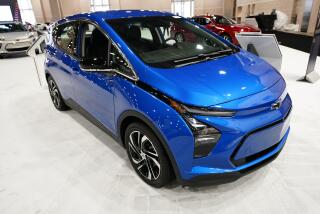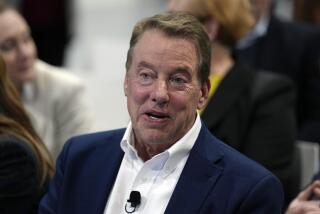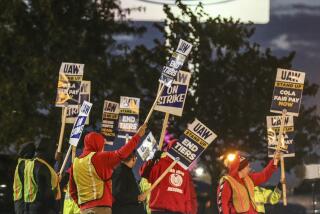Nasser Faces a Tough Test in Restoring Ford’s Reputation
- Share via
DETROIT — It was an astonishing admission from the head of the world’s second-largest auto manufacturer, one whose motto had long been “Quality is Job 1.”
Right after announcing a recall of 13 million Firestone tires late last month, Ford Motor Co. Chief Executive Jacques Nasser was asked about quality at the company. Appearing flustered, he replied, “For quality, I’d say we’re about average. It’s not where we think we should be.”
He had good reason to be concerned. Just five days earlier, the respected consulting firm J.D. Power & Associates came out with its annual Initial Quality Study among new automobile owners, and the news was not good for Ford: The company came in last among the seven major auto makers in the U.S., with the most defects per 100 vehicles.
The low marks come after embarrassing and costly delays plagued Ford’s launches of its Focus, Escape and redesigned Explorer. Each had to be recalled, sometimes multiple times, to fix quality glitches.
Those are among the many troubles that may be crowding Nasser’s mind today as he testifies before a congressional panel in Washington that is looking into why hundreds of Explorers careened out of control or flipped over after their Firestone tires shredded in scores of fatal accidents.
The lagging performance in quality and efficiency, sagging morale at headquarters and rumors of rifts at the highest level in management are all coming down on Nasser’s shoulders. Though analysts and industry experts don’t think Nasser is in imminent danger of losing his job, it has fallen squarely on him to pull the Explorer, and indeed the company’s very reputation, out of the morass of bad news and restore confidence in the Ford brand.
It has distracted from Nasser’s primary mission: to transform Ford from an “old-economy” smokestack manufacturer to an agile, consumer-focused, e-business powerhouse.
All this comes at a terrible time for Ford, with a slow economy taking a toll on car sales. And its market share in trucks, long a Ford bastion, is being eroded by imports and, perhaps most galling, by General Motors Corp.
Two weeks ago, the Insurance Institute for Highway Safety came out with its crash tests of the country’s five full-size pickup trucks, and Ford’s F-series--the country’s best-selling vehicle--came in dead last, with a “poor” rating.
The most recent bruise came last Thursday when the Harbour Report, a highly anticipated annual report on productivity, showed that Ford lost ground to archrival GM in assembly efficiency from 1991 to 2001, declining 2.8% while GM gained 9.4%, as measured in hours worked per vehicle built.
“Productivity at Ford is going the wrong way,” said UBS Warburg analyst Saul Rubin.
As recently as March, Ford was riding much higher. Earnings in 2000 were $6.7 billion, compared with GM’s $4.45 billion. For the first quarter of this year, Ford’s revenue was $42.36 billion, only a hair’s breadth short of GM’s $42.62 billion, raising the possibility that Ford could overtake GM in sales not far in the future.
And although GM’s first-quarter production was cut 20% to trim inventory, Ford’s profit in that period was a four times bigger than GM’s.
But the string of bad headlines, exacerbated by the Firestone saga that won’t go away, has made it a bad year overall for Nasser.
Some of Ford’s problems are “legacy issues” that Nasser inherited when he became chief executive in January 1999, said David Bradley, J.P. Morgan’s auto industry analyst. But “he was in an area of responsibility in product development, so obviously he bears some culpability.”
Bradley traces some of the troubles to Nasser’s setting standards too high in such performance measures as productivity, initial quality and profit per vehicle.
“The company’s performance hasn’t risen as fast as expectations,” he said. “If you’re producing at 90%, and the threshold is 88%, you’re OK, but if you suddenly raise the threshold to 92%, you’re going to fall short.”
What may be beyond Ford’s control is GM’s resurgence in light trucks, in particular full-size pickup trucks and sport-utility vehicles. So far this year GM has gained four percentage points of market share in that sector, taking the edge in large pickups and increasing its lead in large SUVs with the Chevrolet Tahoe and Suburban, and GMC Denali and Yukon XL.
“We believe the biggest near-term risk to Ford isn’t Firestone, it’s GM,” analyst Rod Lache of Deutsche Banc Alex. Brown, wrote in a report to investors this month. “Ultimately, we suspect that Ford will wind up ceding share to GM, since GM has come out with stronger offerings in segments historically dominated by Ford.”
Nasser and Ford continue to be dogged by the Firestone tire ordeal. The $3 billion that Ford says its tire recall will cost will wipe out profit for the second quarter.
Ford initially had a relatively easy time placing blame on the tires, which Bridgestone/Firestone Inc. admitted were badly made.
But the tire maker has been cranking up its attacks on Ford, blaming the Explorer for being badly designed and contributing to the crashes.
Firestone deepened the wounds to Ford by releasing more charts and data, including a report by a Ohio State University professor that concludes what Ford has been desperately trying to parry for months: that the Explorer’s instability is partly to blame for the accidents involving Firestone tires.
Ford has dismissed the report’s methodology, saying it can’t have reached reliable conclusions by testing only three Explorers and two rival SUVs made by GM and Chrysler.
Bridgestone/Firestone CEO John Lampe says Ford has refused to share detailed test data and has handed over only laboratory results that blame the tires.
Ford says it has shared extensive data with Firestone as well as federal regulators.
The feuding has gotten so bad that Nasser refuses to sit at the same table with Lampe and will testify separately, a congressional source confirmed Monday.
And CEO Nasser is not seen as the best public image of Ford. He speaks with a strong Australian accent, reflecting where he was raised. “If you’re dealing with Congress, you want to send an American,” said J.P. Morgan’s Bradley. “It’s not smart to have Nasser go.”
Like many observers, Bradley says Chairman William Clay Ford Jr., great-grandson of Henry Ford and whose name is on the building and the cars, after all, should have stepped up in the role of public spokesman.
Nasser nonetheless is a respected executive, keen on integrating the Internet and creating positions and departments in the company where he sees they are needed. But the blurring speed at which he operates can backfire.
“Jacques moves so quickly on so many fronts that it’s difficult to see how it’s going,” said David Cole, director of the Center for Automotive Studies in Ann Arbor, Mich., and a veteran industry expert. “If you ask an organization to move too much too fast, you get some confusion, and I think you’re seeing some of that.”
(BEGIN TEXT OF INFOBOX / INFOGRAPHIC)
Last in Quality
Ford’s quality ratings have fallen to last place among the seven largest auto makers in the U.S., according to the J.D. Power & Associates annual Initial Quality Survey.
*
Problems per 100 vehicles in the 2001 model year:
Toyota: 115
Honda: 133
Nissan: 145
GM: 146
Industry average: 147
DaimlerChrysler: 154
Volkswagen: 159
Ford: 162
Source: Reuters






